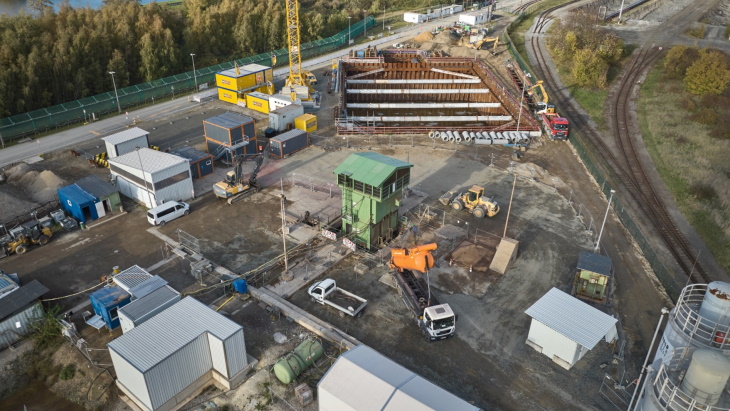Completion of German waste repository delayed
Work to convert the former Konrad iron ore mine into Germany's first repository for low and intermediate-level radioactive waste (LLW/ILW) is running about two years behind schedule, according to the country's federal radioactive waste company, Bundesgesellschaft für Endlagerung (BGE). The repository will not be completed in 2027 as planned, it said.

An aerial view of the Konrad 2 site (Image: BGE)
The Konrad mine - in Salzgitter, Lower Saxony - closed for economic reasons in 1976 and investigations began the same year to determine whether the mine was suitable for use as a repository for LLW/ILW.
In 2002, the Lower Saxony Ministry for the Environment issued a planning approval decision for the Konrad repository. Following multiple legal proceedings, this approval was confirmed by the Federal Administrative Court in 2007. A construction licence was issued in January 2008.
In April 2017, BGE assumed responsibility as the operator of the Asse II mine and the Konrad and Morsleben repositories from the Federal Office for Radiation Protection.
The Konrad mine is being converted for use as a repository under the supervision of BGE. The two mine shafts are being renovated and equipped with the necessary infrastructure underground. Among other things, this infrastructure includes transport galleries and the emplacement areas at a depth of around 850 metres. Above ground, construction work is under way on new buildings, including the reloading hall.
BGE said on 13 June that construction activities for the Konrad repository were well advanced, but there were "still some hurdles to overcome".
It noted all new buildings at Konrad 1 - the conventional part of the repository through which workers and material are brought underground and out again - have now been constructed. All underground cavities necessary for the operation of the repository have also been excavated and the underground expansion is almost complete.
At Konrad 2 - where waste will be accepted and transported underground - the construction of the storage shaft is currently on schedule. However, in a reassessment of the remaining construction work, BGE has concluded that the work is about two years behind schedule. "The completion of the Konrad repository in 2027, which has been assumed since 2017, can no longer be achieved," it said.
BGE said there were three main reasons for the delay at Konrad 2. Firstly, BGE needed longer to redesign the contractual relationships with the general planners than expected when it was founded. The general planners draw up the plans for the buildings and facilities on Konrad 2 on behalf of BGE. Secondly, following the March 2011 accident at Japan's Fukushima Daiichi plant, safety requirements for nuclear facilities in Germany were improved. This also applies to the safety requirements for protection against earthquakes. BGE said it underestimated the task of incorporating the higher safety requirements into the execution planning of all buildings and entailed special efforts for all those involved. Thirdly, it said the implementation planning for all structures is based on the approval for the Konrad repository. In many cases, the planning is accompanied by nuclear approval procedures. These procedures have taken longer than scheduled, BGE said.
The final disposal of up to 303,000 cubic metres of LLW/ILW at Konrad is set to begin in the early 2030s. This waste represents 95% of the country's waste volume, with 1% of the radioactivity. At present, this waste is stored above-ground in interim storage facilities at more than 30 locations in Germany. Once within the Konrad repository, the containers will be immobilised with suitable concrete and securely sealed off during emplacement operations. Once operations are complete, all cavities of the mine will be backfilled and sealed in a manner that ensures long-term safety.
Researched and written by World Nuclear News
- China Institute of Atomic Energy
- Nuclear Power Institute of China
- Southwestern Institute of Physics
- China Nuclear Power Operation Technology Corporation, Ltd.
- China Nuclear Power Engineering Co., Ltd.
- China Institute for Radiation Protection
- Beijing Research Institute of Uranium Geology (BRIUG)
- China Institute of Nuclear Industry Strategy (CINIS)
- China Nuclear Mining Science and Technology Corporation


